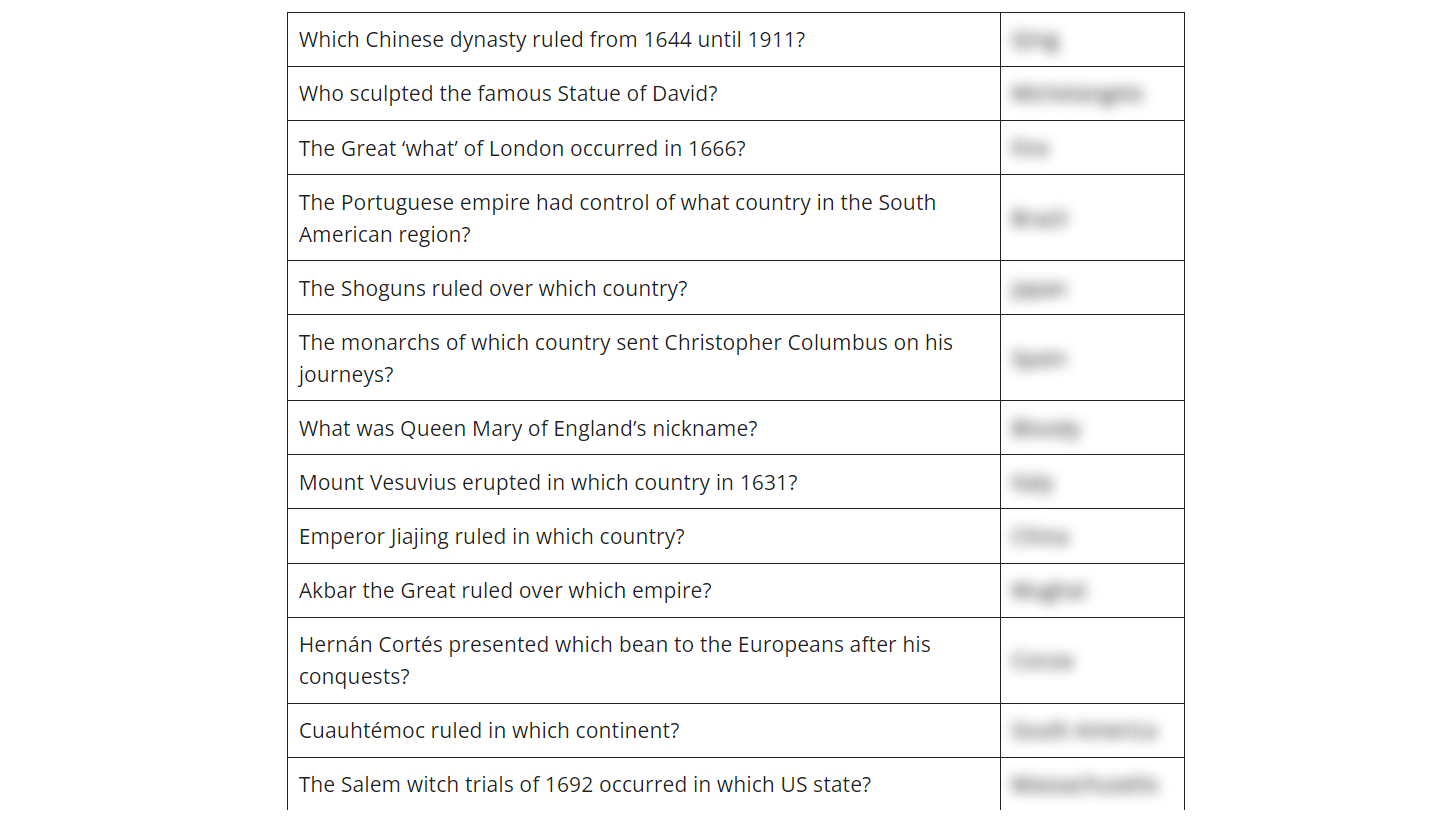Playing games with your work team or friends not only boosts collaboration and creativity but also ensures a great time 1.
In this guide, we’ll explore a list of incredibly enjoyable games that you can effortlessly organize for your coworkers or friends. If you’re looking for a quick overview, here are the top picks we’ll cover:
Type of game | Name of game | Qualities the game will foster |
Cooperative | Online Escape Room | Teamwork and intellectual challenge |
Fill in the Map | Teamwork and educational fun | |
Multiplayer competitive | Codenames | Critical thinking and wordplay |
Skribbl.io | Creativity and quick-thinking | |
Party | Sidewalk Tag | Energy boost and play |
Scattegories | Quick thinking and creativity | |
Connection | The Google Game | Connection and getting to know each other |
FoodTube | Vulnerability and detective work | |
Bucketlist Matching | Emotional connection and personal growth | |
Creativity | Collective Chronicles | Creativity and play |
Geometric Guesswork | Communication and listening | |
Picture Puzzles | Eye for detail and creativity |
Online Group Games for Deeper Connection
These games emphasize social interaction and discussion over competition or mission completion. Ideal for teams aiming to strengthen interpersonal relationships and communication skills.
- The Google Association Game:
This free association game offers a unique way to learn more about each other. Imagine if Google had access to all your memories—what would come up when you search phrases like “the one that got away” or “piñata”? Simulate this engaging exercise with your teammates, delving into amusing, vulnerable, and surprising corners of their minds.
Best for:
Teams that appreciate open-ended conversations, authenticity, and creative thinking. Perfect for breaking the ice, exploring vulnerable conversation topics, or shaking up the usual team dynamics.
Number of players:
Works best with a multiple of three, allowing easy division into trios. A group of 2 or 4 can also function.
How to set up the game:
- Divide into groups:
Use a video conferencing tool with breakout room capabilities (like Zoom) to create groups of three.
- Order up:
Each trio decides the order for asking and answering questions.
- Start the inquiry:
Person 1 asks, “What happens when I Google Person 2 and X?” ‘X’ is any random topic, prompting deep thoughts without actual Googling.
- Associative answers:
Person 2 free-associates based on the topic, sharing the first thing that comes to mind related to ‘X.’ Keep each share to 3 minutes or less.
- Keep It rolling:
Person 2 then asks a similar question of Person 3, and the cycle repeats for about 10 minutes.
- Optional Debrief time:
Pause for each trio to debrief the experience—what they learned, what surprised them, etc.
- Group reconvene:
Bring everyone back to the main meeting room to share highlights and observations.
Whether uncovering quirky revelations or profound insights, the Google Association Game lets you explore a new side of your colleagues.
- Online Group Game: FoodTube
Dive into a playful game, seamlessly blending gentle vulnerability and detective skills to get to know your team on a more personal level. FoodTube involves sharing snapshots of the inside of each team member’s refrigerator and their YouTube homepage’s recommended videos. These become clues into your coworkers’ worlds, creating an enlightening and entertaining experience.
Best for:
Teams looking to deepen personal connections and those who enjoy a bit of detective work.
Number of players:
Ideal for 4-12 players. The more players, the more challenging and engaging the game becomes.
How to set up the game:
- Choose a game meister:
Designate someone to organize and present the photos.
- Capture the images:
Each player takes a photo of the inside of their refrigerator (no tidying up allowed!) and a screenshot of their YouTube homepage’s recommended feed. Players can opt out if they feel uncomfortable.
- Send photos to the game meister:
Players send their images to the game meister through a secure and private method.
- Anonymize & organize:
The game meister renames the image files for anonymity and arranges them in a presentation or slideshow.
- Game time:
During the virtual meeting, the game meister shares their screen, displaying one refrigerator photo and one YouTube screenshot at a time. Players take turns guessing who each set belongs to.
- Reveal & discuss:
After all guesses, the game meister reveals the true owners of each fridge and YouTube feed. This opens conversations about individual tastes, preferences, and unexpected common interests.
- Scorekeeping (optional):
For a competitive edge, players earn points for each correct guess. The player with the most points at the end can win a fun prize, such as a gift card to a popular restaurant or online store.
And just like that, you’ve got a more revealing game than any personality test! The session concludes with newfound insights into your coworkers—what they like, watch, and what’s on their plate!
- Online Group Game: Bucket List Matching
Immerse yourselves in a heartfelt game that’s less about winning and more about understanding—each other and maybe even yourselves. In Bucket List Matching, each person shares their bucket list with the group, who then tries to match it to the teammate.
Best for:
Teams aiming to build deeper emotional connections and open dialogues about personal goals and dreams.
Number of players:
Ideal for 4-12 players. A smaller group allows for more meaningful discussion after each reveal, but the game scales well.
How to set up the game:
- Assign a facilitator:
Designate one person to guide the game, present the lists, and moderate discussions.
- Create bucket lists:
Before the game, ask each team member to privately create a list of ten things they want to achieve before they die. These can be travel goals, skills they want to learn, or personal milestones they want to reach.
- Submit the lists:
Players send their completed bucket lists to the facilitator via email or a secure messaging platform.
- Anonymize and prepare slides:
The facilitator anonymizes each list and prepares a slideshow to present them individually.
- Game time:
The facilitator shares each anonymous bucket list during the virtual meeting. Players take turns guessing who each list belongs to.
- Share and reflect:
After the owner of each list is revealed, allow them to share anything they’d like about their list, whether it’s the story behind a particular item or how they felt while crafting it.
- Optional scoring:
For those who like to keep score, assign points for each correct guess. The player with the most points could win a prize that aligns with an item on their bucket list, like a travel guide or a cooking class voucher.
As you match lists with their creators, the game becomes a touching exchange of hopes and dreams, offering a fresh lens through which to view your colleagues. It’s a gentle but powerful way to deepen empathy and foster a more emotionally intelligent workplace.
Cooperative Games (Co-op)
Any game that puts people on a team will be great for your company or friend group. This fascinating study 2 divided middle school test subjects into three groups: those who played a first-person shooter video game called Modern Warfare 3 cooperatively for two hours, those who played it competitively, and those who didn’t play it.
Two weeks later, these students were paired with a random other student from their same control group (cooperative gaming, competitive, or no gaming) and were assigned to play the Prisoner’s Dilemma (which is a psychological test used to measure how cooperative or self-interested people will act toward each other). Amazingly, those who played cooperatively in Modern Warfare 3 were most likely to behave cooperatively in the Prisoner’s
Dilemma two weeks later! And those who played competitively were least likely to play the
Prisoner’s Dilemma cooperatively. You can use this knowledge to your advantage by creating team-building exercises where everyone works together. Setting up cooperative games within your team can boost your team’s collaborative tendencies outside of just the game.
In the games below, players work together to complete missions, solve puzzles, or achieve other goals. Co-op games are great for strengthening team collaboration and problem-solving skills.
- Fill in the Map: geography meets collaboration.
Is your team savvy about world geography, or would they need help to place Antarctica on the map? Either way, the Fill in the Map game is a great exercise to test your team’s geographical prowess, spark conversations about travel experiences, and learn something new about our vast world.
Best for: Groups who love teamwork mixed with educational fun and those who want to learn more about their teammates’ worldly experiences.
Number of players: Any number, although smaller groups (around 4-6) are more manageable.
How to set up the game:
- Share a map: Provide participants with a blank world map, which can be shared via screen-sharing or as a downloadable file.
- Divide the team: If your team is large, consider dividing it into smaller groups to make the game more interactive.
- Set a timer: Allocate around 20 minutes for the activity.
- Start the game: Teams work together to fill in the names of as many countries as possible. Participants can take turns or work collaboratively in real-time, depending on the platform you’re using.
- Time’s up: Teams share their maps once the timer goes off.
- Check and discuss: Reveal the correct answers and discuss the results. You could award small prizes or accolades for the most accurate or the fastest team.
- Bonus debrief: Take a few minutes to share travel stories, fun facts, or exciting experiences related to the countries that came up during the game. This is a great way to learn about your coworkers’ adventures and aspirations.
Whether you discover a hidden geography whiz or unearth exciting travel stories, this virtual activity will bring your team closer than ever.
- Online escape room
Embark on a thrilling journey without leaving your desk. Virtual escape rooms offer a unique blend of intense problem-solving and teamwork, translating into a powerful bonding experience. This game is for those who revel in challenges, adore puzzles, and enjoy that collective “aha!” moment when a tricky lock finally clicks open.
Best for: Teams who thrive under pressure and love a good intellectual challenge.
Number of players: Up to 10 players
How to set up the game:
- Select a virtual escape room platform: Many online platforms offer various themes. Choose one that aligns with your team’s interests and professional goals. The site TheEscapeRoom.com has a handful of great options.
- Book a time slot: Once the platform is selected, book a suitable time slot for your team. Ensure that everyone’s schedules are accommodated.
- Game time: Log into the virtual escape room at the scheduled time and solve the puzzles as a team. Most platforms guide you through the experience, providing hints when necessary.
- Post-game discussion: After completing the escape room, take some time to debrief. Discuss what strategies worked, what didn’t, and how team dynamics played out under pressure.
Virtual Escape Rooms are a test of individual wit and a celebration of collective intelligence. As you navigate complex puzzles, you’ll gain invaluable insights into how your team thinks, collaborates, and overcomes challenges.
Multiplayer Competitive Games
These are games where individuals or teams compete against each other to achieve specific objectives or scores. They are excellent for fueling a healthy sense of competition and team collaboration.
- Codenames: the word game where strategy meets vocabulary
Ready to merge your love for words with your knack for strategic thinking? Codenames is one of the all-time classic board games for a reason. In the game, you guide your teammates towards the correct words while avoiding those that belong to the opposing team. You’ll be practicing deduction, word association, and teamwork all in one go.
You can use the free online version to play.
As a bonus, board games can help people learn more effectively, improve their memory and attention, and even help with ADHD-related challenges.
Best for: Teams that enjoy a blend of critical thinking and wordplay, perfect for testing how well you know each other’s thought patterns.
Number of players: Ideally, 4-8, but it can be adapted for larger teams by adding more spymasters or guessers.
How to set up the game:
- Join the link: Create a link via https://codenames.game/ and send it out. It’s doubly fun to play while meeting on video chat so that you can also talk.
- Divide into teams: Split your group into two teams, each with a Spymaster and one or more guessers.
- Start the clue-giving: Spymasters take turns giving one-word clues followed by a number that tells the guessers how many cards on the board relate to the clue. For example, “Ocean 2” could point to the words “Beach” and “Whale” on the grid.
- Time for guessing: The guessers then try to figure out which words their Spymaster is leading them to. They must be careful not to pick a word that belongs to the other team or, worse, the assassin word that ends the game immediately.
- Keep score: Teams take turns until all their words are guessed, or someone picks the assassin word. Tally points based on the number of correctly guessed words.
Codenames aren’t just about knowing many words; it’s about reading your teammates’ minds based on the tiniest hints. It’s an engaging way to improve team communication while having a good time. When explaining the rules, just be ready to deal with folks like
https://youtu.be/gUrRsx-F_bs
- Skribbl: unleash your inner Picasso, one scribble at a time
Who knew stick figures and squiggly lines could be so entertaining? Skribbl is the digital equivalent of Pictionary, giving you and your team a chance to draw your way to victory—or at least some good laughs. This browser-based game is an excellent way to get people engaged, smiling, and connecting, all while honing those abstract thinking and artistic (or not-so-artistic) skills.
Best for Teams that want to blend creativity, gentle competition, quick thinking, and a healthy dose of humor.
Number of players: 4-12 (Small enough for everyone to have a turn at drawing, large enough for a variety of guesses)
How to set up the game:
- Navigate to Skribbl.io: Open your web browser and head to the Skribbl.io website. Create a private room and share the link with your team.
- Customize settings: You can select the number of rounds drawing time and add custom words relevant to your team or industry for an added twist.
- Get drawing: Once everyone has joined, click “Start Game.” Players will take turns drawing a word while the others try to guess it. The faster you think, the more points you earn.
- Rotate artists: Each player gets a turn to draw. Choose from one of three words presented to you; your choice will be the next challenge for your team to guess.
- Keep score: The game automatically keeps score based on how quickly and accurately players guess the drawings. At the end of all the rounds, the player with the most points wins.
Celebrate and discuss: After the final round, take a moment to congratulate the winner and talk about the most memorable drawings or guesses. Who knew that a squiggle could be interpreted in so many ways?
Skribbl.io is an opportunity to reflect your team’s creativity, adaptability, and ability to think outside the box—or the doodle, in this case. Whether you’re an aspiring artist or struggling to sketch a straight line, Skribbl.io promises a fun, challenging, and inevitably hilarious experience for everyone.
- Trivia questions

Do you know the answer to any of these excellent trivia questions from Trivia.fyi?
Party Games
Research 3 suggests that video games can positively impact social skills and cognition. Let’s bring these benefits to your team! Are you looking to bring the classic childhood game of tag into the digital age? Say hello to Kumospace’s Sidewalk Tag, a virtual take on the beloved outdoor game.
- Sidewalk Tag: tag, you’re “It” in a virtual world
This interactive platform gives you the excitement of a traditional game of tag but through a virtual landscape where you’ll “run” from one chat bubble to another. It’s a fresh way to encourage team bonding, spatial awareness, and a touch of nostalgia—all from the comfort of your desk.
Just check out this link to purchase the game (it’s free if you have five members or fewer and is otherwise $16/month).
Best for Teams needing a quick energy boost and a dose of playful competition.
Number of players: 4-20 (You’ll need enough players to make the chase exciting but not so many that the game becomes chaotic.)
How to set up the game:
- Access Kumospace: Navigate to the Kumospace website and set up a private room for your team. You can customize the room to make it as straightforward or intricate as possible.
- Explain the rules: Once everyone is in the room, explain that the game follows the classic tag rules. One person is “It,” their objective is to tag another player by navigating their avatar close to another person’s avatar and clicking on them.
- Choose who’s “It”: Randomly select the first person to be “It.” This can be done by drawing names, using a random number generator, or asking for volunteers.
- Start the game: Once “It” is chosen, give them a countdown, and let the chase begin. Players navigate their avatars around the virtual environment, seeking to avoid or capture others.
- Switch roles: When someone is tagged, they become “It” and must tag another player.
- Time it out: Decide beforehand how long the game will last. When the timer rings, the game ends, and everyone can gather to chat about their experiences and strategies.
- Celebrate and debrief: Discuss what strategies worked, share funny moments, or even give virtual team awards like “Most Elusive” or “Fastest Tag.”
Sidewalk Tag combines the best of both worlds: the exhilaration of a physical game of tag with the accessibility of a virtual environment. It’s a fantastic way to shake off the remote work blues and inject a burst of energy into your team, all while exploring the innovative capabilities of virtual spaces. Get ready to run; you’re just a click away from being “It!”
- Scattegories
Unleash your vocabulary and wit in a fast-paced game that challenges you to think outside the box. Scattegories is a classic game that pits your employees or friends against the clock and each other in a race to list unique words or phrases that fit specific categories. This is more than a test of language skills; it’s a dive into creative thinking under pressure. Here is a link to a free online version.
Best for Teams looking to energize their meetings with quick thinking and a dash of competitiveness.
Number of players: 4-12 (The game can be modified for larger groups by splitting into smaller teams.)
How to set up the game:
- Log online: Have everyone log onto the Scattegories website.
- Set the Timer: Decide on the length of time for each round. Typically, this is 3 minutes.
- Pick a letter: In traditional Scattegories, a 20-sided die with letters is rolled to determine the key letter for that round. In an online version, the letter will often be randomized for you.
- Start the clock: Once the key letter and categories are revealed, the clock starts, and everyone begins listing items for each category that start with the key letter. For example, if your letter is “B,” you might need to think of a name that begins with B, a food item that starts with B, a game show that begins with B, etc.
- Time’s up: When time is up, go around and share answers. You only get points for unique solutions that no one else has written down. However, you might get some good laughs at your more creative ventures.
- Tally points: Keep track of points across multiple rounds if playing more than one.
- Declare a winner: The person with the most points at the end is declared the winner. Consider offering a small prize, like a bookstore gift card or a word puzzle service subscription.
Scattegories isn’t just about showcasing your vocabulary; it’s a dynamic game that encourages creative thinking on the fly. Amid the laughter and friendly banter, your team collaborates and riffs off each other’s ideas, making it a perfect blend of learning, challenge, and fun.
Creativity Games
Studies report 4 that people who express their creativity feel better about their lives and report higher happiness levels. You can set up games to help work out your crew’s creative muscles. Creativity games ignite the imagination and foster a playful exploration, making them fun and invaluable for unlocking innovative thinking and strengthening team collaboration.
- Collective Chronicles: spin a yarn, one minute at a time
Collective Chronicles invites each team member to contribute to an evolving tale, one minute at a time. This storytelling game encourages creative thinking, active listening, and collaborative narrative skills. It’s a chance to get whimsical, mysterious, funny, or dramatic while relying on your team’s imagination to build a memorable story.
Best for: Teams eager to stretch their creative muscles and enhance their collaborative storytelling skills.
Number of players: 2-10 (More than 10 could make it hard to keep track.)
How to set up the game:
- Choose a theme or setting: Kick off the game by picking a broad theme or setting that will act as the backdrop for the story. Whether it’s a distant galaxy or a haunted mansion, make sure it’s something that will spark creativity.
- Set the timer: Everyone gets one minute to contribute a piece of the story. Make sure you have a stopwatch or a timer on hand (for a twist, there’s another version of this game where everyone only contributes one word at a time).
- Pick the starter: Choose a person to start the story. It can be anyone—maybe the youngest member or who suggested the game.
- Rotate and narrate: After the first person tells one minute of the story, the next person picks up where they left off, adding their one-minute contribution. The goal is to build on the previous person’s words, maintaining the story’s coherence while introducing new elements. If you only have 2, 3, or 4 people, consider each going several times.
- Record or transcribe (optional): You can record the audio of the session or have someone transcribe it in real time. This can allow you to listen to your story again later on.
- Conclude gracefully: Once everyone has had a chance to contribute, opt for a final round to wrap up loose ends and bring the story to a satisfying conclusion.
- Share and reflect: After the story has been told, take some time to reflect on the experience. What surprising turns did the story take? What moments of collective creativity stood out?
Collective Chronicles is a team-building activity that taps into the fundamental human love for tales and imagination. As your team ventures from plot twist to plot twist, you’ll create a unique story and forge a shared experience that’s as enriching as entertaining.
- Geometric Guesswork: visualizing words through shapes
Ready for a delightful challenge that will sharpen your team’s communication skills and add a dash of artistic flair to your workday? In this game, words are converted into geometric descriptions, and understanding comes to life one shape at a time. This is a fantastic exercise for remote teams aiming to improve what they say and how effectively they say it.
Best for: Teams interested in honing communication and listening skills with a creative twist. The number of players is 5-7 per subgroup, but multiple subgroups can play in parallel.
How to set up the game:
- Initiate a video call: Gather your team on a Zoom call or another video conferencing platform.
- Divide and conquer: Break the group into smaller subgroups of 5-7 people and place them in breakout rooms.
- Assign roles: Within each subgroup, players take turns being the “Geometric Guide” and “Sketchers.”
- Instructions & word generator: Provide each subgroup with instructions on how to play and a random word generator for the Geometric Guides to use.
- Let the game begin: The Geometric Guide selects a random word from the generator and describes it using only geometric terms (e.g., “draw a rectangle in the center, then add a triangle on top”).
- Sketch time: Sketchers listen carefully and draw what they think the Geometric Guide describes.
- Guess and reveal: At any point, a Sketcher can shout out their guess. If correct, they earn a point. Everyone then reveals their drawings on screen.
- Next turn: The next Geometric Guide can be the Sketcher who guessed correctly or another member chosen at random.
- Final Tally: After a predetermined number of rounds, tally up the points and consider giving out a small prize, like a gift card for art supplies.
Geometric Guesswork makes communication a tangible, visible experience, revealing how a single idea can be interpreted in multiple ways. As each word unfolds into a unique piece of art, you’ll gain fresh insights into the nuances of team communication and enjoy a few laughs along the way.
- Picture Puzzles: A photographic adventure in everyday objects
Get ready to see your team’s homes in a new light—literally! In Picture Puzzles, everyone becomes a photographer with a mission: capture an everyday object in a way that renders it almost unrecognizable. This game elevates photography into a fun guessing game while enhancing your team’s observational and interpretive skills.
Best for: Teams with a keen eye for detail and a love for the visual arts. Number of players: 4-20 (The more, the merrier! But consider time for guessing with larger groups.)
How to set up the game:
- Decide a host: This person will take the game through each of its steps.
- Get on the call: Join the Zoom call with each other.
- Choose a Platform: Decide where the pictures will be shared—a Slack channel dedicated to the game, an email thread, or even a shared Google Drive folder.
- Send people off to photograph: Give every 3 minutes to take their first photo. It could be of anything, or you could give prompts, such as “a type of food” or “something found in the bedroom.”
- Share the mysteries: Team members upload enigmatic photos to the chosen platform.
- Let the guessing begin: Underneath each uploaded picture, teammates jot down their best guesses about the object.
- The big reveal: Each photographer unveils the true identity of their objects. You could even keep score and award points for each correct guess.
- Repeat! Go for as many rounds as you’d like.
Celebrate the Details: Consider offering a small prize for the most accurate guesser or creatively photographed object. It could be as simple as a gift card to a popular photography website.
Picture Puzzles invites you to view the ordinary through an extraordinary lens, enriching your ability to see the world—and your teammates—in surprising new ways. It’s a visually engaging game that’s as much about the art of observation as the joy of discovery. If you’d like other connection-type games, you might enjoy MASTER YOUR SKILLS.
Frequently Asked Questions on Group Online Games
What are some group online games?
Some group online games perfect for a professional setting include virtual escape rooms, Scattergories, and Codenames. These games are excellent for team-building and can be easily adapted for large or small groups.
How many people should play in my online game?
The number of people that should play in your online game can vary depending on the game itself. Typically, games like Scattergories and Codenames can accommodate 4 to 10 players, whereas virtual escape rooms and custom games might be best for smaller teams of 4 to 6.
Takeaways on Group Online Games
Best of luck with your online group games! It’s sure to bring about teamwork, connection, and plenty of laughter.
Here’s a quick reminder of some great options:
Type of game | Name of game | Qualities the game will foster |
Cooperative | Online Escape Room | Teamwork and intellectual challenge |
Fill in the Map | Teamwork and educational fun | |
Multiplayer competitive | Codenames | Critical thinking and wordplay |
Skribbl.io | Creativity and quickthinking | |
Party | Sidewalk Tag | Energy boost and play |
Scattegories | Quick thinking and creativity | |
Connection | The Google Game | Connection and getting to know each other |
FoodTube | Vulnerability and detective work | |
Bucketlist Matching | Emotional connection and personal growth | |
Creativity | Collective Chronicles | Creativity and play |
Geometric Guesswork | Communication and listening | |
Picture Puzzles | Eye for detail and creativity |
And if you’d like Tip Son to host an unforgettable in-person game night, you might enjoy this course MASTER YOUR SKILLS.
- https://www.ncbi.nlm.nih.gov/pmc/articles/PMC8715357/
- https://www.researchgate.net/publication/311792939_The_effects_of_playing_cooperative_and_competitive_video_games_on_teamwork_and_team_performance
- https://www.apa.org/pubs/journals/releases/amp-a0034857.pdf
- https://www.ncbi.nlm.nih.gov/pmc/articles/PMC8305859/



